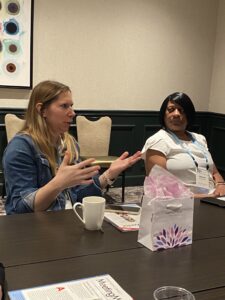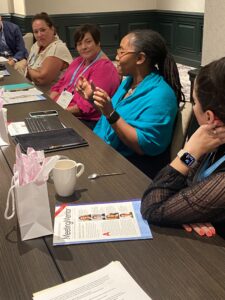MeetingMentor Magazine
Planners Reveal Top Pain Points
 While face-to-face meetings are coming back in a big way, meeting professionals still have a lot of challenges keeping them up at night, from budgets that don’t come close to covering today’s rising costs to unresponsive hotel reps to a lack of support for professional development.
While face-to-face meetings are coming back in a big way, meeting professionals still have a lot of challenges keeping them up at night, from budgets that don’t come close to covering today’s rising costs to unresponsive hotel reps to a lack of support for professional development.
Things are definitely looking up for those who plan face-to-face meetings and events, with both the number of in-person events being planned rising and in growing attendance numbers. But some of the pain points that bedeviled planners pre-pandemic still exist — and some new ones have cropped up.
To learn more about what’s keeping meeting professionals up at night these days, MeetingMentor held a meeting with a select group of eight meeting and event planners during CDX in Nashville this fall. Here’s just some of what they had on their minds.
Budget Woes Are Still a Thing
Almost all of the focus group members said they were struggling to provide the experience they wanted to provide in an era where costs keep rising and budgets do not. “It’s hard to get leadership to understand that this is where we’re at right now,” said one participant, singling out AV costs as a particularly painful budget pain point. “AV companies now want the income of a small country for what used to cost $400,” said one person.
“Our landscape has completely changed since the pandemic,” added another. “We used to be able to rent scooters for a reasonable rate, but now I have to ship them from Florida to Atlantic City because I can’t get a vendor who can provide what I need for even in the ballpark of what we have paid in the past. It’s the same for everything. It used to be simple to source, now it’s difficult to find someone who’s good at what they do and also budget friendly. We have to spend so much more time on all of that now.”
“We couldn’t find a makeup artist for less than $1,000 a day, so we put an ad in the paper and got someone who was reasonable and very good,” said another. “We’re learning to be a lot more creative in how we find third-party vendors.”
And planners find themselves having to constantly negotiate with the hotel over F&B and all those ancillary services that used to be included in the contract, like pads of paper and pens and water for the room, said another.
Some are trying to offset the increased costs with increases in registration fees, others with associations are asking for increased membership dues, while others are trying a combination of both. “Some members feel that our non-member registration rate should go up, but not the member rate. So it’s a balancing act,” said one participant.
 One issue they face when trying to raise registration fees is that attendee expectations tend to increase as well. “When we increase the registration fees, they expect us to provide more in the way of food or some other type of incentive,” said one participant. “We try to do that, but our sponsors don’t have as much disposable income as they used to either.” Another participant who has been raising the registration fee every two years added, “It’s starting to get to the point where members question if it’s worth the educational piece when we’re not giving them a lot of meals and things like that.”
One issue they face when trying to raise registration fees is that attendee expectations tend to increase as well. “When we increase the registration fees, they expect us to provide more in the way of food or some other type of incentive,” said one participant. “We try to do that, but our sponsors don’t have as much disposable income as they used to either.” Another participant who has been raising the registration fee every two years added, “It’s starting to get to the point where members question if it’s worth the educational piece when we’re not giving them a lot of meals and things like that.”
For some participants whose attendees had a limited or fixed income, raising registration fees is a non-starter. “We have to look for other ways to be resourceful and find new revenue streams,” said one participant.
Among the solutions some said were working for them:
• Institute multiple levels of early-bird registration. “We used to do just an early bird and regular registration. Now we have a special price for the first week of registration that’s the lowest they can pay, then it goes up in increments of $200 from there for another three levels. That helps get people to register up front and helps keep them from feeling the impact of increased rates.”
• Dial back on food and beverage, including replacing an open bar with a limited number of drink tickets. However, while this helps meet budgetary requirements, some attendees likely will not be happy about this option. As one planner for a nonprofit professional group said, “Our members’ income also is down, and it becomes a ripple effect because if we start cutting meals, it’ll cost them more to come. And it becomes a time crunch too if we have to send them off to have meals” outside of the conference zone.
Luring in Exhibitors and Sponsors
While the number of meetings is on the rise, it’s still a challenge to bring back exhibitors, participants agreed. Especially for exhibitors in industries that are still struggling to resolve pandemic-era supply-chain or other issues, “They’re not biting like they used to.” This is exacerbated in harder-hit industries, especially those who have experienced budget cuts of their own and are sending fewer people, said another.
“Our attendee numbers still haven’t come back fully yet, but because some of our space shrank, we still had our conferences sell out,” said one participant. “We’re seeing some higher quality folks coming. But it wasn’t fun having to turn some folks away.” And the argument that a smaller number of more highly qualified attendees should be a good incentive to bring in exhibitors and sponsors sounds good, but doesn’t always work, they agreed.
“Some of our smaller meetings didn’t get enough attendance to attract a sponsor, so we had to make budget cuts for the quarter,” explained one.
Sponsors also aren’t interested in some of the bread-and-butter sponsorships like they used to be, they said. “They’re not interested in sponsoring key cards and little things like that. They’ve had to cut budgets too.” However, that person added, “They do still want the keynote introduction though. Those sell out right away.”
Unresponsive Hotel Reps
While booking appropriate space on the right dates at a reasonable rate is definitely still an issue, what’s worse is the lack of attention planners say they’re getting once they do book.
“Getting into a hotel is problematic, and then once you’re onsite, you never know what you’re going to get,” said one person. The others agreed that it can be hit or miss — “We had one person who was super responsive, and she was great onsite, but then we have others who don’t even want to be present. You just have to try to make friends with the other staff who are handling the meeting.”
Another told a sad/scary tale of getting no response after repeated requests for acknowledgement of changes well ahead of the event dates. They ended up having to put through the changes to the event orders on site. “I’ve never had to do that before,” this participant said.” It’s not the level of service we had been used to getting.”
 One thing that helps, said one participant, is having in-person meetings with hotel staff, preferably more than one, well ahead of the event, rather than corresponding solely through email. While others said they’d like to do that — and used to pre-pandemic — budgets right now can’t support those in-person meetings. And, one person noted, with hotel staff turnover being so high these days, the people who developed those relationships with may not be there when it counts. So they end up doing the pre-con meeting once they’re onsite for the event itself.
One thing that helps, said one participant, is having in-person meetings with hotel staff, preferably more than one, well ahead of the event, rather than corresponding solely through email. While others said they’d like to do that — and used to pre-pandemic — budgets right now can’t support those in-person meetings. And, one person noted, with hotel staff turnover being so high these days, the people who developed those relationships with may not be there when it counts. So they end up doing the pre-con meeting once they’re onsite for the event itself.
“We all have friends in the hotel industry and we know how much they’ve been cut back, so I feel for them,” said one participant. “I agree that if you can show up earlier for a face to face and create that connection, it does help. But we can’t do that for every program.”
Accounting and Reconciliation Delays
Several reported that it’s becoming more difficult than ever to get the information they need to close out an event’s billing. “We’re missing our internal deadlines because we’re not getting information,” said one person.
It’s particularly frustrating for those who meet with hotel staff at the end of each day during the event to go through invoices. “When the bill comes in late after we all signed off on everything every day, sometimes it’s like, where did this come from?”
One way to get around this issue, said one participant, is to stay an extra day or two after the event is over and go through everything. “Once you leave that property, it’s out of sight, out of mind. I tell them I’ll pay the bill, or a good portion of the bill, before I leave, and they do give me the resources I need. It’s been very successful.”
A ConferenceDirect representative noted that CD does provide support when it comes to auditing and reconciliation, even for those who don’t use the company’s housing services.
Generational and Technology Challenges
When it comes to hiring and working with the newest generation of professionals, “All they want are jobs that are meaningful and won’t suck out their souls,” said one participant. Which is an aspiration most can empathize with, but the downside is that now, when people don’t like their jobs, they just leave. “It’s no longer a negative if someone only stays a year.”
And the newest generation coming into the work force is used to technology that is seamless and user friendly — which is not always what you’re given to deal with, especially in the association meetings world, they said. “They look at how we do things and say. ‘You should have a system where you just put this in and it flows.” But when you work in a nonprofit that’s just recently stopped accepting fax registrations, well, reality tend to collide with the younger generation’s expectations.
And it’s not just the younger generations who aren’t thrilled with the state of the art in event tech as it plays out in their everyday lives. “We did a technology audit and nothing talks to anything else — the database, the hybrid platform, the mobile app, the learning system — nothing talks to anything else,” explained one participant. “So it’s a lot of manual work to have to repeatedly input things. Half the battle right now is doing all that unnecessary work” — especially for those who are in a one-person meeting department juggling multiple events.
Finding Qualified Help
Even with the challenges involved in hiring and retaining new talent, there’s a screaming need for more help, several participants agreed. “Just last week, I got an email from the hotel saying our room block is about to end and we’re facing $7,000 in attrition. I was on vacation, but I had to pull out my laptop,” said one. Another added, “I question how long we can sustain doing it all ourselves.”
While it won’t help overnight, one longer term strategy that some have found successful is investing in an internship program with local universities. “Even if they don’t have hospitality degrees, they can come in and do accounting for your event, while also exposing them to your industry or your organization,” said one participant.
In the meantime, it can take months to find a good candidate, and even then you have to carefully vet them, they said. For example, for a recent registration coordinator hire, one participant found that some of the recruitment agencies were embellishing resumes, “so even if their resume was glowing, once they landed the job, we found out the housing experience was really working a front desk,” one person said.
“Now we know we have to ask more specific questions and give them scenarios to work through. It takes a lot of time, though, which is hard when we have so much going on with our meetings.”
Lack of Support for Professional Development
A lot of associations aren’t putting allocations in their budgets for professional development anymore, participants said. “One of the first questions we are asked by people we interview is about professional development, and we just don’t have anything but on-the-job training.”
Another added, “You need to get out and have those conversations and meet with your peers and share struggles and pain points. If organizations invested in their employees, they might stick around longer.”
One added that it can help to take advantage of local opportunities, such as Association Forum in Chicago, and chapter meetings of national meeting planning associations. “It’s low cost and it’s local, and it’s really helpful.”
Another addressed the issue of asking for compensation increases. “We do what we do for love, not because we’re in it for the money, right? But it would be amazing if our leadership could base compensation increases on performance, like the cost saving report at the end of an event. But they really have no idea what all it is that we do.”
Hybrid Meetings
Some participants do still livestream portions of their in-person events, especially the sessions attendees can earn professional credit for. “Nobody likes to do a happy hour on a hybrid platform, so we don’t do anything related to networking,” one participant added.
While video recording is more expensive than the old audio-only recordings many associations used to depend on, some say the revenue they make from the virtual recording outweighs the expense. The expense and lack of return on livestreaming makes it a no-go for several in the room, though some have found workarounds. “We had been losing money on livestreaming, but now we use Zoom and our LMS and it works wonders,” said one participant. Another said it helps to set all the sessions that will be streamed (live or on demand) in one room to reduce the expense of having to reset the AV in different rooms.
To help provide more of that in-person experience without livestreaming, another said, “A week and a half after our in-person, we stream the recording for three and a half days, and have the speakers join in for a 30-minute Q&A.”
“People who don’t have the money or travel or have children at home they can’t leave area are always thanking us for providing the virtual option,” said another. “And some people don’t care about networking, they just want the education. It’s been a great source of revenue for us.” But only if you charge attendees for it, said another. “Our sponsors aren’t interested. They want to be in front of people.”
And it’s not for every group, said another. “Our members basically told us if it’s not face to face, they don’t want it.”
Many thanks to our MeetingMentor Focus Group participants: Jan Williamson, Association for Partners in Christian Education; Kristin Keith, National Association of Personal Financial Advisors; Stephanie Dernak, Association of Dental Support Organizations; Malinda Armstrong, Adhesive and Sealant Council; Amberly Jackson, Disabled American Veterans; Markita Bullock, School Nutrition Association; Lisa Ramirez, Equipment Leasing and Finance Association; and Andrea Mikus, FIRST.
What are some of your pain points? Contact editor Sue Pelletier at sue.pelletier@conferencedirect.com.
Free Subscription to
MeetingMentor Online
"*" indicates required fields
About ConferenceDirect
About MeetingMentor